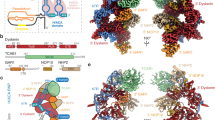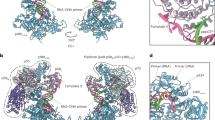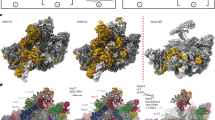Abstract
H/ACA ribonucleoprotein particles (RNPs) are a family of RNA pseudouridine synthases that specify modification sites through guide RNAs. They also participate in eukaryotic ribosomal RNA processing and are a component of vertebrate telomerases. Here we report the crystal structure, at 2.3 Å resolution, of an entire archaeal H/ACA RNP consisting of proteins Cbf5, Nop10, Gar1 and L7ae, and a single-hairpin H/ACA RNA, revealing a modular organization of the complex. The RNA upper stem is bound to a composite surface formed by L7ae, Nop10 and Cbf5, and the RNA lower stem and ACA signature motif are bound to the PUA domain of Cbf5, thereby positioning middle guide sequences so that they are primed to pair with substrate RNA. Furthermore, Gar1 may regulate substrate loading and release. The structure rationalizes the consensus structure of H/ACA RNAs, suggests a functional role of each protein, and provides a framework for understanding the mechanism of RNA-guided pseudouridylation, as well as various cellular functions of H/ACA RNP.
This is a preview of subscription content, access via your institution
Access options
Subscribe to this journal
Receive 51 print issues and online access
$199.00 per year
only $3.90 per issue
Buy this article
- Purchase on Springer Link
- Instant access to full article PDF
Prices may be subject to local taxes which are calculated during checkout




Similar content being viewed by others
References
Ofengand, J. Ribosomal RNA pseudouridines and pseudouridine synthases. FEBS Lett. 514, 17–25 (2002)
Kiss, T. Small nucleolar RNAs: an abundant group of noncoding RNAs with diverse cellular functions. Cell 109, 145–148 (2002)
Meier, U. T. The many facets of H/ACA ribonucleoproteins. Chromosoma 114, 1–14 (2005)
Torchet, C. et al. The complete set of H/ACA snoRNAs that guide rRNA pseudouridylations in Saccharomyces cerevisiae. RNA 11, 928–938 (2005)
Lestrade, L. & Weber, M. J. snoRNA-LBME-db, a comprehensive database of human H/ACA and C/D box snoRNAs. Nucleic Acids Res. 34, D158–D162 (2006)
Ganot, P., Bortolin, M. L. & Kiss, T. Site-specific pseudouridine formation in preribosomal RNA is guided by small nucleolar RNAs. Cell 89, 799–809 (1997)
Ni, J., Tien, A. L. & Fournier, M. J. Small nucleolar RNAs direct site-specific synthesis of pseudouridine in ribosomal RNA. Cell 89, 565–573 (1997)
Balakin, A. G., Smith, L. & Fournier, M. J. The RNA world of the nucleolus: two major families of small RNAs defined by different box elements with related functions. Cell 86, 823–834 (1996)
Ganot, P., Caizergues-Ferrer, M. & Kiss, T. The family of box ACA small nucleolar RNAs is defined by an evolutionarily conserved secondary structure and ubiquitous sequence elements essential for RNA accumulation. Genes Dev. 11, 941–956 (1997)
Rozhdestvensky, T. S. et al. Binding of L7Ae protein to the K-turn of archaeal snoRNAs: a shared RNA binding motif for C/D and H/ACA box snoRNAs in Archaea. Nucleic Acids Res. 31, 869–877 (2003)
Morrissey, J. P. & Tollervey, D. Yeast snR30 is a small nucleolar RNA required for 18S rRNA synthesis. Mol. Cell. Biol. 13, 2469–2477 (1993)
Atzorn, V., Fragapane, P. & Kiss, T. U17/snR30 is a ubiquitous snoRNA with two conserved sequence motifs essential for 18S rRNA production. Mol. Cell. Biol. 24, 1769–1778 (2004)
Mitchell, J. R., Cheng, J. & Collins, K. A box H/ACA small nucleolar RNA-like domain at the human telomerase RNA 3′ end. Mol. Cell. Biol. 19, 567–576 (1999)
Girard, J. P. et al. GAR1 is an essential small nucleolar RNP protein required for pre-rRNA processing in yeast. EMBO J. 11, 673–682 (1992)
Bousquet-Antonelli, C., Henry, Y., G'elugne, J. P., Caizergues-Ferrer, M. & Kiss, T. A small nucleolar RNP protein is required for pseudouridylation of eukaryotic ribosomal RNAs. EMBO J. 16, 4770–4776 (1997)
Lafontaine, D. L., Bousquet-Antonelli, C., Henry, Y., Caizergues-Ferrer, M. & Tollervey, D. The box H + ACA snoRNAs carry Cbf5p, the putative rRNA pseudouridine synthase. Genes Dev. 12, 527–537 (1998)
Watkins, N. J. et al. Cbf5p, a potential pseudouridine synthase, and Nhp2p, a putative RNA-binding protein, are present together with Gar1p in all H BOX/ACA-motif snoRNPs and constitute a common bipartite structure. RNA 4, 1549–1568 (1998)
Henras, A. et al. Nhp2p and Nop10p are essential for the function of H/ACA snoRNPs. EMBO J. 17, 7078–7090 (1998)
Baker, D. L. et al. RNA-guided RNA modification: functional organization of the archaeal H/ACA RNP. Genes Dev. 19, 1238–1248 (2005)
Charpentier, B., Muller, S. & Branlant, C. Reconstitution of archaeal H/ACA small ribonucleoprotein complexes active in pseudouridylation. Nucleic Acids Res. 33, 3133–3144 (2005)
Wang, C. & Meier, U. T. Architecture and assembly of mammalian H/ACA small nucleolar and telomerase ribonucleoproteins. EMBO J. 23, 1857–1867 (2004)
Henras, A. K., Capeyrou, R., Henry, Y. & Caizergues-Ferrer, M. Cbf5p, the putative pseudouridine synthase of H/ACA-type snoRNPs, can form a complex with Gar1p and Nop10p in absence of Nhp2p and box H/ACA snoRNAs. RNA 10, 1704–1712 (2004)
Rashid, R. et al. Crystal structure of a Cbf5–Nop10–Gar1 complex and implications in RNA-guided pseudouridylation and dyskeratosis congenita. Mol. Cell 21, 249–260 (2006)
Hamma, T., Reichow, S. L., Varani, G. & Ferre-D'Amare, A. R. The Cbf5–Nop10 complex is a molecular bracket that organizes box H/ACA RNPs. Nature Struct. Mol. Biol. 12, 1101–1107 (2005)
Manival, X. et al. Crystal structure determination and site-directed mutagenesis of the Pyrococcus abyssi aCBF5–aNOP10 complex reveal crucial roles of the C-terminal domains of both proteins in H/ACA sRNP activity. Nucleic Acids Res. 34, 826–839 (2006)
Girard, J. P., Bagni, C., Caizergues-Ferrer, M., Amalric, F. & Lapeyre, B. Identification of a segment of the small nucleolar ribonucleoprotein-associated protein GAR1 that is sufficient for nucleolar accumulation. J. Biol. Chem. 269, 18499–18506 (1994)
Ishitani, R. et al. Alternative tertiary structure of tRNA for recognition by a posttranscriptional modification enzyme. Cell 113, 383–394 (2003)
Liang, X. H. et al. A genome-wide analysis of C/D and H/ACA-like small nucleolar RNAs in Trypanosoma brucei reveals a trypanosome-specific pattern of rRNA modification. RNA 11, 619–645 (2005)
Russell, A. G., Schnare, M. N. & Gray, M. W. Pseudouridine-guide RNAs and other Cbf5p-associated RNAs in Euglena gracilis. RNA 10, 1034–1046 (2004)
Heiss, N. S. et al. X-linked dyskeratosis congenita is caused by mutations in a highly conserved gene with putative nucleolar functions. Nature Genet. 19, 32–38 (1998)
Marrone, A., Walne, A. & Dokal, I. Dyskeratosis congenita: telomerase, telomeres and anticipation. Curr. Opin. Genet. Dev. 15, 249–257 (2005)
Hoang, C. & Ferre-D'Amare, A. R. Cocrystal structure of a tRNA Psi55 pseudouridine synthase: nucleotide flipping by an RNA-modifying enzyme. Cell 107, 929–939 (2001)
Pan, H., Agarwalla, S., Moustakas, D. T., Finer-Moore, J. & Stroud, R. M. Structure of tRNA pseudouridine synthase TruB and its RNA complex: RNA recognition through a combination of rigid docking and induced fit. Proc. Natl Acad. Sci. USA 100, 12648–12653 (2003)
DeLano, W. L. The PyMOL User's Manual (Delano Scientific, San Carlos, California, 2002)
Acknowledgements
We are grateful to D. J. Patel for his steady interest and encouragement in this project. We thank D. Patel and A. Serganov for critically reading the paper, and J. Duan, Y. Kang and W. Wang for assistance and discussion. We thank N. Shimizu and M. Kawamoto for help at SPring-8 beamline BL41XU. This research is funded by the Chinese Ministry of Science and Technology. Author Contributions L.L. was responsible for biochemical and crystallization experiments; K.Y. determined the structure and wrote the paper. Both authors designed experiments and discussed results.
Author information
Authors and Affiliations
Corresponding author
Ethics declarations
Competing interests
Coordinates and structure factors have been deposited in the Protein Data Bank under the accession code 2HVY. Reprints and permissions information is available at www.nature.com/reprints. The authors declare no competing financial interests.
Supplementary information
Supplementary Data
This file contains Supplementary discussion, methods, references, Table S1 and Figure S1–S7. (PDF 1165 kb)
Rights and permissions
About this article
Cite this article
Li, L., Ye, K. Crystal structure of an H/ACA box ribonucleoprotein particle. Nature 443, 302–307 (2006). https://doi.org/10.1038/nature05151
Received:
Accepted:
Published:
Issue Date:
DOI: https://doi.org/10.1038/nature05151
This article is cited by
-
Structure of human telomerase holoenzyme with bound telomeric DNA
Nature (2021)
-
Detailed view of human telomerase enzyme invites rethink of its structure
Nature (2018)
-
Contribution of protein Gar1 to the RNA-guided and RNA-independent rRNA:Ψ-synthase activities of the archaeal Cbf5 protein
Scientific Reports (2018)
-
RNA-dependent pseudouridylation catalyzed by box H/ACA RNPs
Frontiers in Biology (2018)
-
Crystal structure of an ASCH protein from Zymomonas mobilis and its ribonuclease activity specific for single-stranded RNA
Scientific Reports (2017)
Comments
By submitting a comment you agree to abide by our Terms and Community Guidelines. If you find something abusive or that does not comply with our terms or guidelines please flag it as inappropriate.



